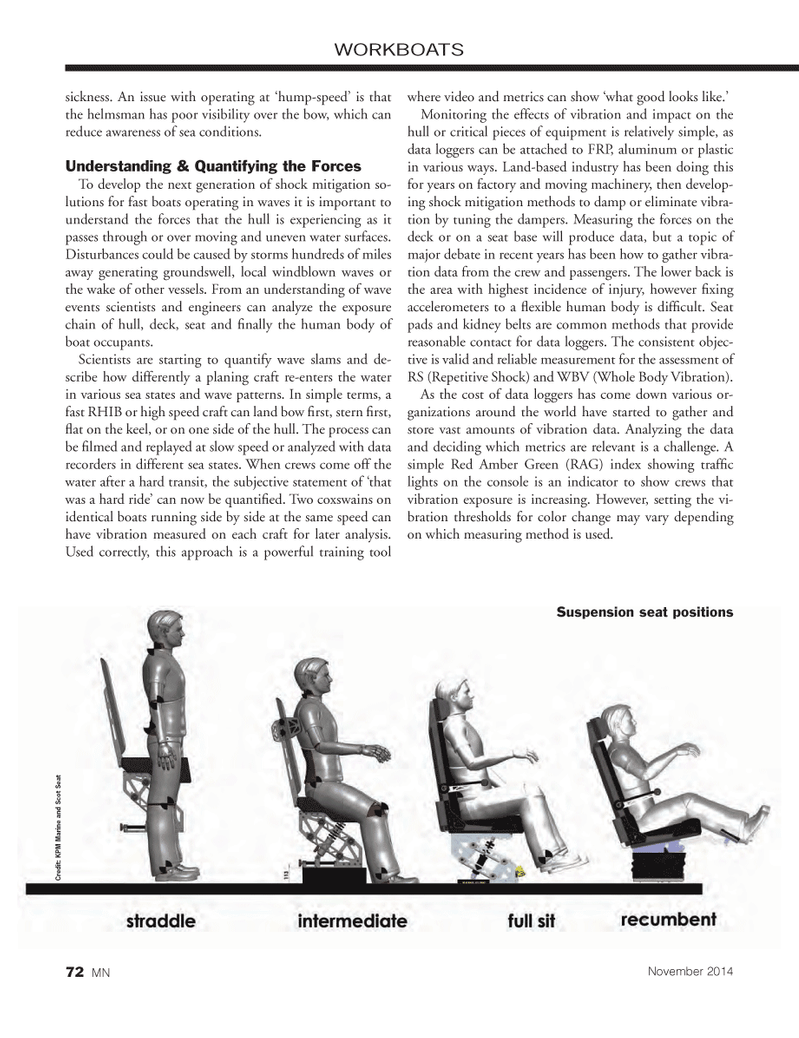
Page 72: of Marine News Magazine (November 2014)
Workboat Annual
Read this page in Pdf, Flash or Html5 edition of November 2014 Marine News Magazine
sickness. An issue with operating at ‘hump-speed’ is that the helmsman has poor visibility over the bow, which can reduce awareness of sea conditions.
Understanding & Quantifying the Forces
To develop the next generation of shock mitigation so- lutions for fast boats operating in waves it is important to understand the forces that the hull is experiencing as it passes through or over moving and uneven water surfaces.
Disturbances could be caused by storms hundreds of miles away generating groundswell, local windblown waves or the wake of other vessels. From an understanding of wave events scientists and engineers can analyze the exposure chain of hull, deck, seat and fi nally the human body of boat occupants.
Scientists are starting to quantify wave slams and de- scribe how differently a planing craft re-enters the water in various sea states and wave patterns. In simple terms, a fast RHIB or high speed craft can land bow fi rst, stern fi rst, fl at on the keel, or on one side of the hull. The process can be fi lmed and replayed at slow speed or analyzed with data recorders in different sea states. When crews come off the water after a hard transit, the subjective statement of ‘that was a hard ride’ can now be quantifi ed. Two coxswains on identical boats running side by side at the same speed can have vibration measured on each craft for later analysis.
Used correctly, this approach is a powerful training tool where video and metrics can show ‘what good looks like.’
Monitoring the effects of vibration and impact on the hull or critical pieces of equipment is relatively simple, as data loggers can be attached to FRP, aluminum or plastic in various ways. Land-based industry has been doing this for years on factory and moving machinery, then develop- ing shock mitigation methods to damp or eliminate vibra- tion by tuning the dampers. Measuring the forces on the deck or on a seat base will produce data, but a topic of major debate in recent years has been how to gather vibra- tion data from the crew and passengers. The lower back is the area with highest incidence of injury, however fi xing accelerometers to a fl exible human body is diffi cult. Seat pads and kidney belts are common methods that provide reasonable contact for data loggers. The consistent objec- tive is valid and reliable measurement for the assessment of
RS (Repetitive Shock) and WBV (Whole Body Vibration).
As the cost of data loggers has come down various or- ganizations around the world have started to gather and store vast amounts of vibration data. Analyzing the data and deciding which metrics are relevant is a challenge. A simple Red Amber Green (RAG) index showing traffi c lights on the console is an indicator to show crews that vibration exposure is increasing. However, setting the vi- bration thresholds for color change may vary depending on which measuring method is used.
WORKBOATS
Suspension seat positions
Cr edit: KPM Marine and Scot Seat
November 2014 72 MN
MN Nov14 Layout 66-81.indd 72 10/27/2014 9:48:53 AM

 71
71

 73
73
